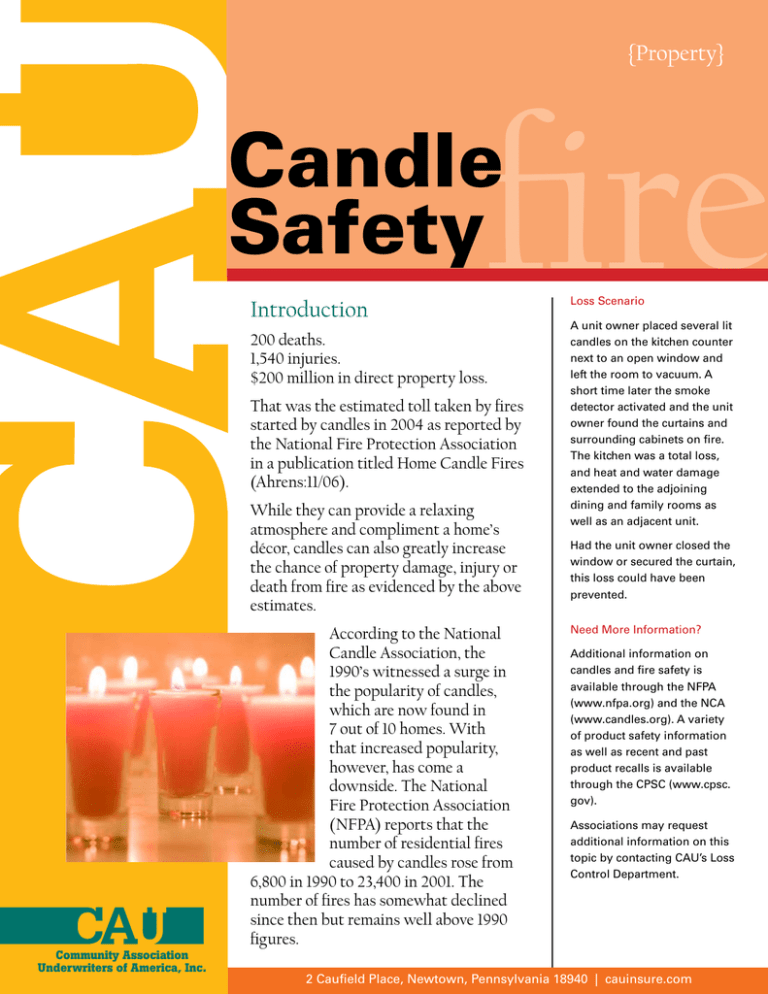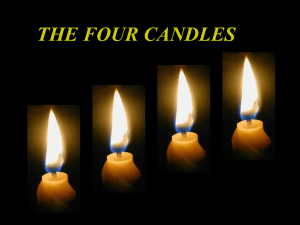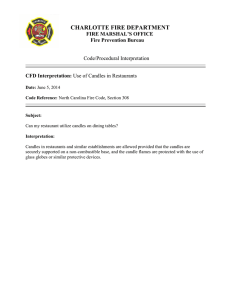
{Property}
fire
Candle
Safety
Introduction
200 deaths.
1,540 injuries.
$200 million in direct property loss.
That was the estimated toll taken by fires
started by candles in 2004 as reported by
the National Fire Protection Association
in a publication titled Home Candle Fires
(Ahrens:11/06).
While they can provide a relaxing
atmosphere and compliment a home’s
décor, candles can also greatly increase
the chance of property damage, injury or
death from fire as evidenced by the above
estimates.
Community Association
Underwriters of America, Inc.
According to the National
Candle Association, the
1990’s witnessed a surge in
the popularity of candles,
which are now found in
7 out of 10 homes. With
that increased popularity,
however, has come a
downside. The National
Fire Protection Association
(NFPA) reports that the
number of residential fires
caused by candles rose from
6,800 in 1990 to 23,400 in 2001. The
number of fires has somewhat declined
since then but remains well above 1990
figures.
Loss Scenario
A unit owner placed several lit
candles on the kitchen counter
next to an open window and
left the room to vacuum. A
short time later the smoke
detector activated and the unit
owner found the curtains and
surrounding cabinets on fire.
The kitchen was a total loss,
and heat and water damage
extended to the adjoining
dining and family rooms as
well as an adjacent unit.
Had the unit owner closed the
window or secured the curtain,
this loss could have been
prevented.
Need More Information?
Additional information on
candles and fire safety is
available through the NFPA
(www.nfpa.org) and the NCA
(www.candles.org). A variety
of product safety information
as well as recent and past
product recalls is available
through the CPSC (www.cpsc.
gov).
Associations may request
additional information on this
topic by contacting CAU’s Loss
Control Department.
2 Caufield Place, Newtown, Pennsylvania 18940 | cauinsure.com
{Property}
Candle Fire Facts
The NFPA publication reveals some interesting
trends regarding candle fires during a five-year
period from 2000-2004, including:
•54% of home candle fires occurred when some
form of combustible material was left or came
too close to a candle. In 20% of those cases, the
candle was unattended.
•4% of fires were started by people (usually
children) playing with candles.
•Falling asleep was a factor in 12% of home candle
fires and 25% of the associated deaths.
•38% of home candle fires started in the bedroom,
resulting in 35% of the associated deaths.
•December (14%) had almost twice the number of
home candle fires of an average month (8%).
•Christmas Day was the peak day of the year for
home candle fires. Christmas Eve ranked second
and New Year’s Day was third.
Candles and Fire Safety
A 2001 pilot study by the U.S. Consumer Product
Safety Commission estimated that nearly 85% of
candle fires could be prevented if people followed
three basic safety rules:
1.Never leave a burning candle unattended.
2.Never burn a candle on or near anything that might catch fire.
3.Keep candles out of the reach of children and
pets.
ASTM International, a voluntary standards
organization, has published five standards
covering fire safety, emissions, labeling
requirements, standard terminology and candle
accessories. The intent of these standards is to
reduce the frequency of candle fires, and NCA
members have pledged to manufacture candles in
accordance with these standards.
There have been over 100 product recalls since
1990 involving candles and candle accessories.
Most of the recalls are due to fire hazards.
Information concerning product recalls is available
at www.cpsc.gov.
A Safer Alternative
An electric candle warmer is a safer alternative to
burning a candle. These devices, similar to crock
pots, use low heat instead of an open flame to
melt candle wax and allow the candle’s scent to
permeate throughout a space. These devices also
eliminate the production of soot, which over time,
can damage ceilings, walls, floors and personal
belongings. Candle warmers are readily available at
department and specialty stores. Only purchase a
candle warmer that is Underwriters Laboratory®
(UL) listed.
What CAU Recommends:
•Consider using a UL-listed candle warmer
instead of a lit candle.
If you do burn candles:
•Keep at least one foot, in all directions, between
candles and combustibles such as decorations,
bedding or curtains.
•Make sure that curtains are secured and cannot
be blown over the candle by wind.
•Keep candles in a place where they cannot be
knocked over by a pet.
•Keep candles, lighters and matches out of the
reach of children.
•Never leave a lit candle unattended and never
leave a child alone in a room with a lit candle.
•Burn candles on sturdy, noncombustible holders
that cannot tip over easily and are large enough to
collect dripping wax.
•Keep candle wicks trimmed to 1/4” and extinguish
them when there is 2” of wax remaining or 1/2” if
the candle is in a container.
•Use flashlights during a power outage and never
carry a lit candle.
•Extinguish all candles before you leave the house
or go to bed.
•P urchase candles that are properly labeled and
made by a reputable manufacturer belonging to
the NCA.
© 2007 by Community Association Underwriters of America, Inc., All Rights Reserved.
Community Association Underwriters of America, Inc. does business as “Community Association Underwriters Agency” in New York and CAU in Nevada.
IMPORTANT NOTICE - The information presented by CAU in this Risk Management Guide is based on information from sources which we believe to be reliable, but is not guaranteed and
may not be a complete statement of all available data. Any suggested actions recommended by CAU are based solely upon an analysis of available industry data and our best judgment.
You are encouraged to have your legal counsel review all of your proposed plans and policies before implementing them.
2 Caufield Place, Newtown, Pennsylvania 18940 | cauinsure.com | CAU Risk Management Guide P-4(4/07)




